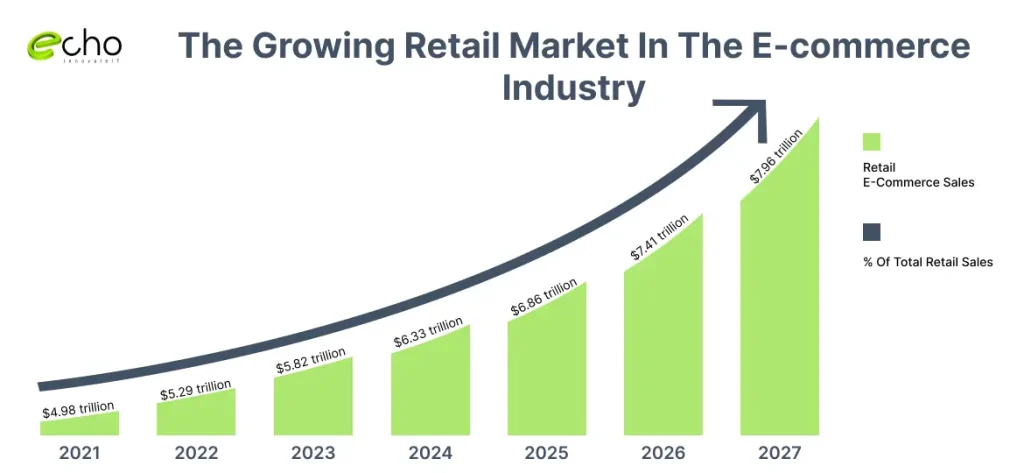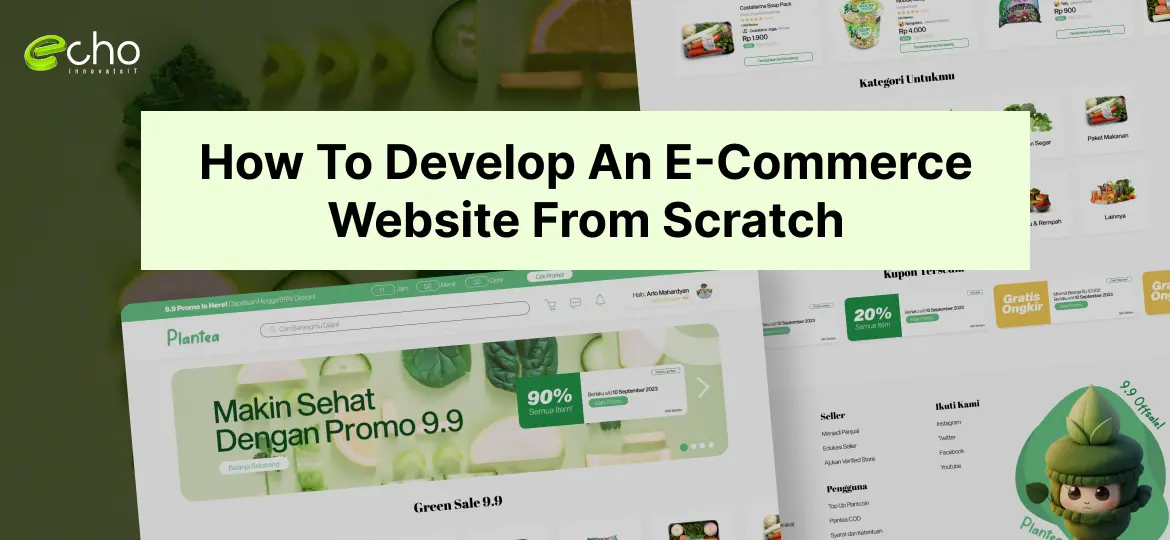You must have heard about popular websites like Amazon, Etsy, Shopify, and Walmart. These are examples of the best ecommerce platforms that have gained global popularity through their strong online visibility. An ecommerce website is an online platform in which businesses can buy and sell their products through a medium. This allows sellers to sell their services directly to their consumers over the Internet.
In 2024, Statista reported almost 26.6 million ecommerce websites available in the global market today. This means millions of shoppers are already enjoying online shopping, which is likely to increase in the next few years. If you are thinking of starting ecommerce website development, you are at the right place. There are many benefits to building an e-commerce business. Let’s understand in detail how you can get started.
The internet has transformed nearly every aspect of our lives, from socializing and entertainment to work and research. One of the biggest changes is in how we shop. Today’s generation, and the ones to follow, have grown up in a world where the internet is essential, and as they spend more, ecommerce will continue to thrive. Currently, 43% of shoppers use the internet and social networks to research products before making a purchase. By 2024, U.S. ecommerce revenue is expected to hit $476 billion, making it an essential part of the retail landscape.
For retailers, having an ecommerce website is no longer optional—it’s a necessity for reaching customers. An online shopping website allows businesses to tap into new markets and provides resilience in case physical stores have to close. Whether you’re just starting a business or looking to expand, an ecommerce platform provides access to a global audience and the ability to build brand recognition before opening a brick-and-mortar location.
Why Should You Invest In eCommerce Website In 2024: Top Market Insights

Before diving into developing an online store website, it is vital to know why you should invest in it. Firstly, there’s no limit to reaching your desired customers. It means whether you have a small business or a large shopping platform, if people like your products, you can sell them anywhere in the world. Another benefit is accessibility. Unlike physical stores, which are open for a limited number of hours, an online store can work 24/7 so that users can buy at their convenience.
Additionally, an online website is more cost-effective than a brick-and-mortar store that requires timely maintenance like utilities, staffing, rent, etc. What else? You can provide personalized experiences to your customers through recommendations, marketing messages, customer interactions, seamless checkouts, and more. Lastly, you can track user behavior and gather valuable insights to find out their preferences, competitors, and purchase patterns to launch new marketing strategies and improve shopping experiences.
Now let’s look into the latest market findings in the ecommerce industry:
- According to Statista, retail e-commerce sales are predicted to exceed 4.1 trillion US dollars globally by 2024, and this figure is expected to rise further in the future years.
- Another research suggests that global ecommerce sales will reach $6.3 trillion in 2024, representing an 8.76% growth over previous years. Sales will expand at a 7.8% CAGR between 2024 and 2027, reaching $8 trillion by 2027. This demonstrates how eCommerce is becoming a more profitable option for businesses worldwide.
- Ecommerce sales in the United States have continuously increased for more than a decade, reaching a record high of $1.12 trillion in 2023. The United States accounts for nearly half of all eCommerce sites worldwide.
- Reports from Klarna suggest that 83% of buyers conduct internet research before visiting physical stores, while 72% use their cell phones for in-store research. The majority of shopping begins online, with 44% starting with internet searches and 41% at online retailers, making online shopping channels as important as physical ones.
- Lastly, when making a purchase, 99% of internet shoppers read reviews, and 96% of buyers actively hunt for negative feedback.
How to Build a Successful Ecommerce Website: A Guide to Starting Your Online Store
When it comes to creating a successful ecommerce website design, businesses can control the entire customer experience, from branding to shipping and customer service. If you’re wondering how to develop an ecommerce website, you have options: you can build it yourself or hire an expert. Understanding the ecommerce website development cost and the cost-effective ecommerce options available can help you make the right decisions. Many businesses also ask, “Can WordPress do ecommerce?” The answer is yes—WordPress is an affordable, customizable solution for building an ecommerce web page that meets your needs.
Building an ecommerce store from scratch doesn’t have to be daunting. If you’re thinking about how to start an online shopping site or how to build a website to sell stuff, there are plenty of tools and resources to help you get started. Whether you’re seeking custom ecommerce web design or looking to work with an ecommerce website company, the right technology can support your growth. Understanding the ecommerce website cost and choosing the best ecommerce technology will ensure your business is set up for long-term success.
In 2020, 11.5% of sales in the first quarter were from ecommerce sales, and with the ongoing impact of COVID-19, more people are shopping online than ever before. The future of retail is digital, and the best ecommerce websites will be those that offer excellent online services, building customer loyalty for the post-pandemic world.
Simple Steps To Develop An eCommerce Website For Your Business
Ecommerce web development is one of the most crucial steps to present a strong ecommerce business. Although it sounds challenging, choosing a reliable online store builder can be a plus point. Let’s understand step by step how you can build an ecommerce shop website with the below-mentioned steps:
Choose A Hosting Platform
The first crucial step is web hosting. A hosting platform is like the support system of your ecommerce website. It provides the necessary resources and server space to bring your website to the web. Finding a compatible hosting platform can be time-consuming. Make sure to check their uptime guarantee, which means your website will be available to visitors all the time.
A strong security infrastructure is vital for protecting your website from cyber dangers such as hacking and data leaks. We offer reliable and prompt customer service and a hosting provider with scalable plans that allow you to upgrade your resources without interruption. In addition, select a plan that provides the best value for money. There are different types of hosting platforms to choose from. Shared hosting, dedicated hosting, VPS hosting, etc. You may select one based on your preferences.
Design Your Ecommerce Website
The next step is to design your ecommerce website. Creating a well-designed shopping website can boost your sales and attract a large number of visitors. For this, you can use design tools like Wix and Squarespace to design user-friendly sites. CMS platforms like WordPress and Shopify provide various customization options.
The roadmap to creating a well-designed website is sticking to the common web design elements used in most ecommerce websites. Use an intuitive layout format, ensure loading speed is fast, add CTA’s, ensure a secure checkout process, and optimize your website from time to time for higher accessibility.
Add Website Pages And Relevant Links
An ecommerce website usually has these common pages and generated links to enhance the experience of online shoppers. It includes:
- Homepage
- About Us
- Cart page
- Product pages
- User profile
- Checkout page
- Contact Us
You’ll also need to include links to these pages in your website’s navigation so that customers can easily find and access the necessary pages. Make sure to add each page accordingly.
Create Your Online Store
The next step is creating your brand online. It involves a careful organization and presentation of your products. For this, your product needs to have a product title with a relevant image and description. It would help if you had to add other details like price, sizing options, and product stock availability. Create logical categories so that clients may easily locate what they’re looking for.
For example, if you offer clothing, you may include categories such as “Men’s,” “Women’s,” and “Kids.” To lead clients through your product categories, implement a sophisticated search function so that customers can quickly find certain products.
Set up Payments And Shipping
Next, integrate the payment system so that customers can purchase your products easily. There are numerous payment processors available, so you must select the one that is appropriate for your organization. PayPal, Stripe, and Authorize.net are examples of popular payment gateways.
Nowadays, most eCommerce websites have “Scan & Pay” or mobile payment options such as Google Pay, PayPal, Apple Pay Cash, and more. If you’re shipping real things, you can also accept COD (cash on delivery) payments.
Test And Launch Your Website
Once you have successfully finished the above steps, preview your e-commerce website and use various web testing methods to check its security, usability, and functionality. Make sure everything is functioning properly. Once you have cleared the testing phase, it’s time to launch your website through advertisements and promoting strategies. Use social media, email marketing, and SEO to attract customers. Use analytics tools to monitor website performance.
Conclusion
Ready to ace your ecommerce game with the best outcome? Building an eCommerce website provides various benefits to people and organizations wishing to sell items or services online. Once you’ve decided what to offer and how to sell it, you can promote your products through a fully functional eCommerce store. Hire Echoinnovate IT and make an online store with zero experience from scratch.
We have a team of excellent web developers, software engineers, IT experts, and QA testers to give you all-round support from start to end. Please chat with our executive today and learn more about our services.
FAQs
What are the key steps to developing an eCommerce website from scratch?
Start by defining your business goals and target audience. Then, choose a tech stack (like WordPress with WooCommerce, Shopify, or custom solutions), and design a user-friendly interface with essential pages (home, product pages, checkout). Develop and integrate features such as product listings, shopping cart, secure payment processing, and order tracking. Finally, thoroughly test the site for usability and security, and prepare it for launch.
Which platform should I choose for my eCommerce website?
The best platform depends on your needs and budget. For quick setups, Shopify and WooCommerce are popular, user-friendly options with customizable templates. For a highly customized solution, you may opt for frameworks like Magento or develop a custom site using tools like Laravel or Django.
What essential features should an eCommerce website include?
Core features for an eCommerce site include a product catalog, search functionality, shopping cart, secure checkout, payment gateway integration, user accounts, and order tracking. Additional features like product reviews, wish lists, and customer support (like chatbots) can also enhance the user experience.



